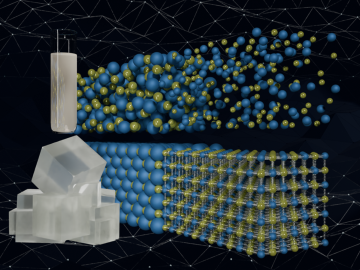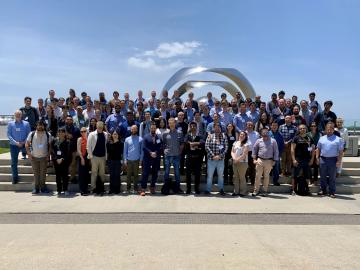
Filter News
Area of Research
- Advanced Manufacturing (2)
- Biological Systems (1)
- Biology and Environment (31)
- Computational Biology (2)
- Computational Engineering (2)
- Computer Science (7)
- Energy Frontier Research Centers (1)
- Energy Science (34)
- Fusion and Fission (8)
- Fusion Energy (7)
- Isotopes (6)
- Materials (67)
- Materials for Computing (15)
- National Security (15)
- Neutron Science (28)
- Nuclear Science and Technology (12)
- Nuclear Systems Modeling, Simulation and Validation (1)
- Quantum information Science (8)
- Supercomputing (60)
News Type
News Topics
- (-) Advanced Reactors (37)
- (-) Biomedical (70)
- (-) Education (5)
- (-) Machine Learning (64)
- (-) Nanotechnology (58)
- (-) Polymers (31)
- (-) Quantum Science (89)
- 3-D Printing/Advanced Manufacturing (137)
- Artificial Intelligence (127)
- Big Data (70)
- Bioenergy (109)
- Biology (126)
- Biotechnology (38)
- Buildings (65)
- Chemical Sciences (83)
- Clean Water (32)
- Composites (33)
- Computer Science (216)
- Coronavirus (47)
- Critical Materials (28)
- Cybersecurity (34)
- Element Discovery (1)
- Emergency (4)
- Energy Storage (107)
- Environment (202)
- Exascale Computing (65)
- Fossil Energy (8)
- Frontier (61)
- Fusion (63)
- Grid (70)
- High-Performance Computing (125)
- Hydropower (12)
- Irradiation (2)
- Isotopes (58)
- ITER (9)
- Materials (147)
- Materials Science (145)
- Mathematics (11)
- Mercury (12)
- Microelectronics (4)
- Microscopy (51)
- Molten Salt (10)
- National Security (81)
- Neutron Science (163)
- Nuclear Energy (113)
- Partnerships (68)
- Physics (64)
- Quantum Computing (52)
- Security (29)
- Simulation (61)
- Software (1)
- Space Exploration (26)
- Statistics (4)
- Summit (70)
- Transportation (92)
Media Contacts

Scientists have developed a new machine learning approach that accurately predicted critical and difficult-to-compute properties of molten salts, materials with diverse nuclear energy applications.

Researchers at ORNL have developed an innovative new technique using carbon nanofibers to enhance binding in carbon fiber and other fiber-reinforced polymer composites – an advance likely to improve structural materials for automobiles, airplanes and other applications that require lightweight and strong materials.

Members of the Quantum Science Center, or QSC, gathered at an all-hands meeting in Baton Rouge, Louisiana, in mid-May to reflect on the remarkable accomplishments from the past five years and to prepare for what members hope to be the next five years of the center.

Paul is exploring the next frontier: bridging quantum computing with neutron science. His research aims to integrate quantum algorithms with neutron scattering experiments, opening new possibilities for understanding materials at an atomic level.

The fifth annual Quantum Science Center, or QSC, Summer School at Purdue University, held Apr. 21 through Apr. 25, 2025, welcomed its largest group of students to date. Experts from industry, academia and national laboratories gathered at the Purdue Quantum Science and Engineering Institute to share their research in multiple areas of quantum science.

A research team from the Department of Energy’s Oak Ridge National Laboratory, in collaboration with North Carolina State University, has developed a simulation capable of predicting how tens of thousands of electrons move in materials in real time, or natural time rather than compute time.

As demand for energy-intensive computing grows, researchers at ORNL have developed a new technique that lets scientists see how interfaces move in promising materials for computing and other applications. The method, now available to users at the Center for Nanophase Materials Sciences at ORNL, could help design dramatically more energy-efficient technologies.

Scientists at ORNL have developed a vacuum-assisted extrusion method that reduces internal porosity by up to 75% in large-scale 3D-printed polymer parts. This new technique addresses the critical issue of porosity in large-scale prints but also paves the way for stronger composites.

Jesse Labbé aims to leverage biology, computation and engineering to address societal challenges related to energy, national security and health, while enhancing U.S. competitiveness. Labbé emphasizes the importance of translating groundbreaking research into practical applications that have real-world impact.
Researchers at Oak Ridge National Laboratory have developed a modeling method that uses machine learning to accurately simulate electric grid behavior while protecting proprietary equipment details. The approach overcomes a key barrier to accurate grid modeling, helping utilities plan for future demand and prevent blackouts.


